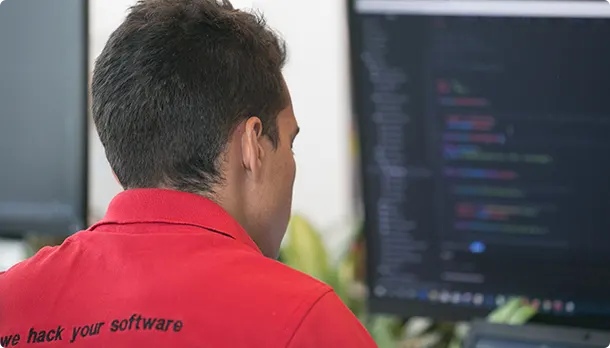We offer the integration of security into the development + operations (DevOps) methodology during the software development lifecycle (SDLC). As opposed to many DevSecOps solutions, at Fluid Attacks, we are not entirely dependent on tools and place more value on our ethical hackers' skills to ensure greater accuracy in testing. We recognize that speed without precision is useless.
Our security solutions in your DevSecOps integration can help optimize your development process from the first uploaded commit and continue doing so after the software is in production. You can rely on us to discover how exposed your systems are to risk. We do this through penetration testing, reverse engineering and automated methods such as SAST, SCA and DAST. DevSecOps with Fluid Attacks is a cultural change within your organization where every team member can become convinced that security is everyone's responsibility.
Benefits of DevSecOps
Optimal integration of security testing
Our security testing, integrating DevSecOps techniques such as SAST, DAST and SCA, supports your whole software development process while ensuring smooth communication between our red team and your developers.
DevSecOps DAST, SAST and SCA
DAST assesses your applications in execution for security issues related to deployment configuration, business logic and data. SAST scans static code to identify coding and design errors that lead to weaknesses. And SCA focuses on vulnerabilities in third-party components used by your product. We apply these techniques continuously while you develop.
Manual and precise work
In our DevSecOps solution, security testing goes beyond the use of automated tools to leverage ethical hackers expertise and discover everything that can pose a cybersecurity risk within your IT systems. This allows us to guarantee very low rates of false positives and false negatives in our projects.
Legacy languages and methods
We hack legacy applications coded in old-established languages, including COBOL, RPG, PL1 and TAL. In addition, we integrate with any development method such as Waterfall, Agile and DevOps.
Early detection of vulnerabilities in code
Since our continuous hacking advances simultaneously with the developers' work, vulnerabilities in your code are quickly identified at early development stages.
DevSecOps vulnerability management
As security assessments advance, you receive detailed reports continually in our platform. This facilitates your understanding of your systems' risk exposure, the prioritization of vulnerabilities for remediation, and tracking progress within your organization.
Break the build
At Fluid Attacks, we have a DevSecOps agent to break the build. Within our DevSecOps solution, we can break the build in any continuous integration pipeline without making the mistake of doing so with false positives or lies.
High vulnerability remediation rates
At Fluid Attacks, we help you ensure high vulnerability remediation rates in your IT systems. By breaking the build in the continuous integration pipeline, we can encourage you to quickly repair those weaknesses that can generate severe impacts to your business.
Do you want to learn more about DevSecOps?
We invite you to read in our blog a series of posts focused on this solution.
DevSecOps FAQs
What does DevSecOps stand for?
DevSecOps stands for "development," "security" and "operations."
What is DevSecOps methodology?
Teams doing DevSecOps focus on bringing security to every stage of the development and operations cycle, implementing practices that ensure that software is secure before every deployment.
Why is DevSecOps important?
As the number of cyber threats and the cost of cyberattacks skyrocket, it is necessary to understand that system security is just as important as functionality and innovation. By committing to security from the early stages of the SDLC, teams reduce time spent on remediation, as well as its associated costs, and create technology that is secure for users.
What are the advantages of DevSecOps vs. DevOps?
DevOps enables collaboration between the development and operations teams to increase the frequency of deployments, but security is usually left to be assessed only at the end of each release. DevSecOps brings the security team's work from the very beginning of the project. Some advantages include a decrease in remediation costs, as vulnerabilities are found and fixed earlier, continuous improvement in secure coding and greater expansion of shared responsibility.
How to implement DevSecOps?
DevSecOps is a whole culture in which you will need to incrementally enable the development, operations and security teams to collaborate, shift security considerations to earlier stages of development, conduct training on secure coding, perform security assessments and remediation, decide on security-driven policies, among other practices. We offer a detailed roadmap in our dedicated blog post.
What are DevSecOps best practices?
Actions that support your implementation of security throughout the SDLC include making everyone across teams aware of their accountability for security, leveraging human knowledge to quickly and continuously test small changes to the system for vulnerabilities, and preventing vulnerable changes from being deployed. Learn about these and more practices in our dedicated blog post.
How are application security testing tools used in DevSecOps?
Tools can be used in combination with manual assessments in the implementation of security testing throughout the development and operations cycle. Our recommendation is that always, including in DevSecOps, security tools be used in combination with manual pentesting. Some security testing techniques may be conducted earlier than others. For example, SAST can be done manually in combination with tools as soon as there's code to review, but manual and automated DAST can be introduced only if there's a build artifact to attack. Learn more about how we use DevSecOps tools in combination with manual security testing in our dedicated blog post.










